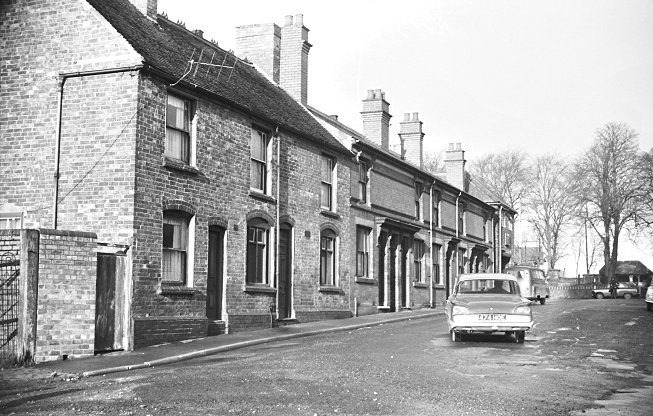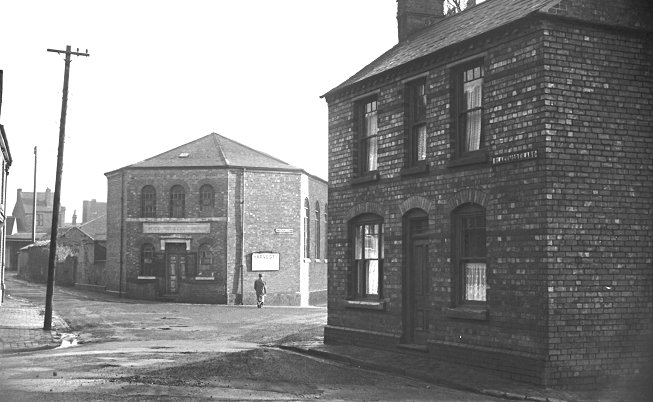Blakemore’s Lane
Elsewhere on this site Bev Parker describes
the small family-based enterprises that marked Darlaston in
the first half of the nineteenth century. All sorts of
nails, screws, bolts, tubes, bridle bits, latches, locks,
and particularly gun locks were made in backyard workshops
by families specializing in a particular trade. The 1841
Census indicates that Blakemore’s Lane, close to the centre
of town, was typical of the area. There were over 230
inhabitants living in some 43 dwellings. It was a young
population, with almost half under 20 years old. |
|

Blakemore's Lane. Based on Joseph
Welch's 1838 map of Darlaston. |
Ninety-six are listed as employed, four of them
apprentices: 12 labourers, mostly agricultural, 13 gun lock
filers, 6 lock filers, 7 shoe makers, 8 bit makers, 4 screw
makers, 4 “nailers,” several lock, gun lock and screw
forgers, 5 charwomen, a tailor, a latch maker and – a
musician. Quiet it was not! (The musician William Hawkins,
it emerges from later census data, was a violinist, and
blind from the age of two). Several of the families in the
Lane were inter-related by marriage. They included the
Barbers, the Wilkes’ and the Longmores. |
Death of Joseph Foster
These families appear in a Staffordshire
Advertiser report on Saturday 19 March 1836 of the trial
of Edward Wilkes for murder. It concerned a family spat
fuelled by drink which led to the death of a man called
Joseph Foster the year before. Based on the article, and the
census of 1841, the key participants were as follows. Thomas
and Hannah Barber, aged 39 and 29, lived in Blakemore’s Lane
with 5 children, including the 1 year old Charles – my great
grandfather – and infant Hannah. He was a gun lock filer. A
couple of doors away lived Hannah Barber’s parents, James
and Hannah Longmore, in their sixties; James, a lock filer,
was one of only two or three freeholders with property worth
£10 in the Lane who had obtained the right to vote following
the 1832 Reform Act. Living with the Longmores was another
of their daughters, Elizabeth, and her husband Thomas
Wilkes, aged 25, with two children. Thomas Wilkes’ father,
Thomas Sr., lived in the Lane, and like his son was a bridle
bit maker. Thomas Jr. had a sister Elizabeth recently
married to a man called Clewitt, a shoe maker, also living
in the Lane. His unmarried brother Edward Wilkes, 23, lived
near-by, possibly with the Longmores. Others living in the
Lane will have moved away by the time of1841 census. Joseph
Foster had married Hannah Nightingale in 1829, and doubtless
had a family, but it’s not clear where they lived. Tracking
the participants is not easy because names Foster and Wilkes
are among the commonest at this time in Darlaston: and the
first names Thomas, Hannah and Elizabeth crop up frequently
in the story. |
| The old cottages at the northern
end of Blakemore's Lane. |
 |
A Drinking Session
During the morning and afternoon of
Wednesday, June 10th, 1835, some half a dozen friends were
drinking together. They included Joseph Foster, a big man
aged about 26, his brother-in-law Daniel Nightingale, a gun
lock filer, Thomas Clewitt, the shoemaker, and three others.
They consumed 9 quarts of ale in the morning, then moved on
and at about two in the afternoon drank a further 6. All
except Clewitt continued drinking till the evening, when he
re-joined them in Thomas Barber’s house. Why were they not
at work? Was it a holiday? In 1850 the Morning Chronicle
in an account of the West Midlands gun trade reported that
the lock forgers and filers “frequently idled away the
Monday and Tuesday of every week... in drinking and card
playing.” This particular group of friends seem to have
extended their long week-end as far as Wednesday! |

Blakemore's Lane in the 1960s.
The Fight
Some time after 9 pm, while he was at Thomas
Barber’s, Clewitt heard a row in Blakemore’s Lane; he hopped
out of the window and found his wife Elizabeth and her
brother Thomas Wilkes Jr. “having words”. Thomas Wilkes got
into a fight with Clewitt and they fell to the ground. A
large crowd gathered, including Thomas’ brother Edward who
joined the fight. Joseph Foster came out of Barber’s house
and helped a witness called John Rubery to pull Clewitt from
under Thomas Wilkes. In doing so according to other
witnesses he pushed Edward Wilkes to the ground, saying
“Damn your eyes, what have you to do with it?” Thomas Wilkes
Sr., the Wilkes brothers’ father, appeared on the scene
along with Thomas Barber who allegedly struck “old Wilkes”
with a ‘drill bow’ (part of an old-style manual ‘bow
drill’); Wilkes Sr. exclaimed that Barber should be ashamed,
took the ‘bow’ and broke it over his knee.
According to Hannah Barber, Edward Wilkes
tried to throttle her husband. Witnesses for the prosecution
claimed Foster gave no provocation, but those for the
defence claimed he was raging drunk when he knocked Edward
Wilkes down. No-one could deny that Edward Wilkes then went
to James Longmore’s house and returned with an iron bar. It
was given to him by one Eliza Parkes, according to a single
woman, Sarah Wilkes (a nailer who lived in the Lane,
probably unrelated to the accused); she and another witness
saw Eliza take it from under her apron and give it to Edward
Wilkes, who hid it under his leathern apron.
Foster was by now standing hatless 4 or 5
yards from Longmore’s house on the outside of the crowd.
Halting for a second, Edward Wilkes rushed forward and
struck Foster on the head twice from behind with the iron
bar. A witness John Hinds recalled “It rattled on his head
like a blow on a hollow turnip.” Foster staggered and was
caught by Rubery; someone was heard to cry, “Oh Lord, you’ve
killed Joe Foster!” or, perhaps more authentically, “Oh Ned,
thee hast kill’d him.” Wilkes was said to have replied, “If
I ha’nt, I will before I’ve done with him!” Hannah Barber
testified that he told her, “That big man, Joe Foster, who
has been sitting in your house, I will kill before I go out
of the lane.”
Foster was then carried to Thomas Barber’s
house, Wilkes returning to Longmore’s. Foster was not in
fact dead; he was patched up, and went home. Some of the
participants in the fight were taken before the magistrates
two weeks later; Foster also appeared drunk on this
occasion, according to the defence, and “wet through,” and
fell over. He went to work the next day and the following
day he saw a doctor. He later went to the doctor again to
ask for a sick note; then the doctor was called to see him a
few hours later, when he became very ill and showed symptoms
of inflammation of the brain. He died six weeks after the
fight on 25th July. |

Looking from Blakemore's Lane to the United
Methodist Church in Great Croft Street.
The Trial
Following the coroner’s inquest at the
beginning of August 1835, Edward Wilkes was committed to
Stafford County Gaol for the wilful murder of Joseph Foster.
His trial took place 9 months after the incident, in the
Crown Court at Staffordshire Assizes on Wednesday 16th March
1836. The newspaper report paints a picture that will be
familiar to followers of court-room dramas today. The Wilkes
family closed ranks and Clewitt, who Foster was trying to
help when he was killed, appeared as a witness for the
defence of his brother-in-law: he gave details of the
drinking, and of Foster’s falling down drunk when called
before the magistrates. Thomas Barber did not apparently
testify, perhaps because of his part in the fight, but his
wife Hannah was one of over half a dozen witnesses for the
prosecution, several of whom saw Wilkes strike Foster and
threaten to kill him.
Two surgeons, Abel Rooker, who had treated
Foster after the attack, and Edward Best had both assisted
at a post mortem, and maintained their belief that his death
resulted from the blows to the head. In cross-examination
the defence suggested that an excess of drink, or Foster’s
being cold and wet through later in the month, or having
suffered a blow to the head when he fell on that occasion,
could have accelerated his death. The doctors showed that
though Foster’s skull was not broken, the damage to his
brain was typical of the effect of blows from the iron bar.
None of the defence witnesses had seen the attack on Foster,
but claimed there was provocation by the deceased. Counsel
for the defence tried to discredit Sarah Wilkes’ evidence,
pointing out that she had three illegitimate children. The
judge Mr Justice Williams told the jury that they must
choose who to believe, and to determine if the blows had
caused Foster’s death, and if the attack was unprovoked. The
jury clearly decided that Wilkes was provoked, and their
verdict was guilty of manslaughter. Wilkes was sentenced to
6 months in gaol. |
Aftermath
Edward Wilkes presumably served his
sentence. Eliza Parkes, who handed him the iron bar, stood
by her man, and they were married in December the same year.
By the time of the 1841 Census, the families
were still all living close together in Blakemore’s Lane:
the Clewitts, Thomas Wilkes Sr. and family, the now widowed
Hannah Longmore with Thomas Wilkes Jr., his wife and family
of five children, the Barbers close by with seven children,
and not far away Edward and Eliza Wilkes and their new
daughter Ann. The Wilkes brothers became bolt and screw
makers, the Barbers continued in the gun trade.
Hannah Longmore died in 1845: she was 73.
Her daughters died young: Elizabeth Wilkes at the age of 30
in 1843, and Hannah Barber aged 54 in 1859 – having given
birth to twelve children. Edward Wilkes died in 1862, aged
50; by 1871 Eliza Wilkes was living with some of her
children in neighbouring Great Croft Street, her son Edward
Jr. described as a bolt and nut maker employing 6 people.
Foster’s widow Hannah ended up living with
her mother Nancy Nightingale and died in 1858. I have not
found what happened to any children she may have had; her
will was proved on the oaths of her two brothers, Edward and
Daniel Nightingale.
|

The area in 1901. |
|
With thanks to
Bev Parker
Ancestry.co.uk in association with The National Archives
The British Newspaper Archive
FreeREG.org.uk for Parish Records |
 |
Return to
the
previous page |
|